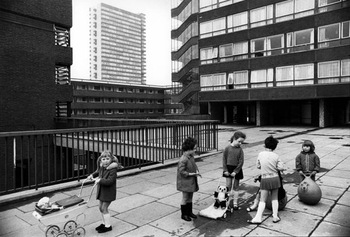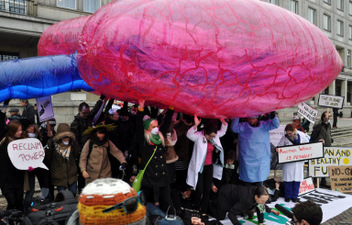 Photo ©Tony Ray-Jones/RIBA Library Photographs Collection. Photo ©Tony Ray-Jones/RIBA Library Photographs Collection. This blog was originally posted at http://saherhasnain.wordpress.com/2013/01/15/environmental-justice-case-study-pepys-estate-deptford/ on January 15, 2013 by saherhasnain The scenario: A social housing estate in Deptford of Lewisham, London, situated on the banks of the Thames, near a busy transportation route and an industrial site. It was previously the Royal Victoria Dockyard where British warships were constructed. It is characterized by the presence of a number of housing blocks, the completion of which resulted in winning a Civic Trust design award. The area has also been refurbished in recent times. Primary site for background information on the location: ukhousing Problems: The estate has faced a number of problems over time: 1. Physical and social changes accompanied with the newer development, of which the singleaspect blog gives a richer description here 2. Noise pollution from a scrapyard near the center of the estate. The Royal Docks nearby also suffer from noise pollution, but from airplane traffic from the London City Airport. This site is a shining example of citizen science and successful multi-stakeholder collaboration at play. The citizens were assisted by the “Mapping Change for Sustainable Communities” by the London 21 sustainability network and University College London under the UCL-led UrbanBuzz Programme. London Sustainability Exchange, under the Environmental Justice programme provided the second pilot area. The citizens were taught how to use the noise monitoring devices, took their own measurements and made their own map. Further, detailed information on the mobilisation of the residents and the participation of the Mayor and Environment Agency can be found here and here. 3. Air pollution problems also arising from the same scrapyard and proximity to traffic routes, also analysed as part of the citizen science initiative through the London Sustainability Exchange. This time, the citizens took samples to analyse air quality using diffusion tubes for NO2 levels, Eco Badge ozone detection kits and a novel surface wiping method. The results were analysed through the Lancashire University and the results were translated into a series of maps. This contribution influenced the siting of air pollution monitoring units near the estate and it is hoped that the information will help with addressing the environmental quality concerns of the community. Further details can be found with mappingforchange.org.uk The Pepys Estate area can be viewed on google maps below, with reference to the towers, transportation routes, metal and waste recycling plant, Pepys park and the community forum:
0 Comments
Gabriele Messori and Izzy Braithwaite Adapted from a blog post at http://climatesnack.com/2014/01/30/cough-for-coal-at-cop19/#more-1673  Our team taking part in Cough4Coal outside the 'Coal and Climate Summit' Our team taking part in Cough4Coal outside the 'Coal and Climate Summit' Neither of us had imagined we’d end up carrying a pair of giant pink lungs in front of the Polish Ministry of Economy on a cold November morning. Why were we there? It’s a long story… We were in Warsaw for COP19, the annual UN climate talks (COP = Conference of the Parties). The aim of the talks is to reach a global deal to tackle climate change in 2015, which will come into force in 2020. We went as part of a delegation of students from Healthy Planet UK, a small, student-led group which seeks to raise awareness about the links between climate and health, and to advocate for UK policy that benefits both health and the environment. As students, researchers and young people, our motivation was the growing body of evidence that climate change poses a major threat to global health, and that sustainable development presents major opportunities for public health. Examples of such climate-health synergies (sometimes called health ‘co-benefits’) can be found across energy, transport, housing and food policy – and quite possibly elsewhere too. Air pollution – bad for health, bad for the climate We know that greenhouse gas emissions affect health indirectly through their contribution to climate change, via changing temperatures and rainfall patterns. Although carbon dioxide has no direct health effect except at high concentrations, it is often, if not invariably, produced alongside other air pollutants. These include substances such as particulate matter, ozone, nitrogen and sulphur oxides, which are emitted both in energy production and motorised transport. Some are greenhouse gases themselves, and all are harmful to our health with myriad effects on our lungs, blood vessels and even cancer risk. The cumulative impact of chronic exposure shortens lives and exacerbates a range of other medical conditions. Around the world, man-made outdoor air pollution accounts for an estimated 2.5 million excess deaths every year. Indoor air pollution (much of it from inefficient cookstoves) accounts for at least as many again, which means that overall air pollution is one of the leading killers globally. Lessons about how politics works… Given the clear evidence that air pollution from burning fossil fuels is so bad for health, combined with the urgency of tackling climate change, you might think governments would be rushing to capitalise on those win-wins. This is where the inflatable lungs come in. Whilst some countries are already taking the kinds of steps that we need, cutting emissions and simultaneously reducing air pollution, over the course of the talks it became fairly clear that some others are working very hard to promote a fossil-fuel dependent future. Almost all of the conference sponsors were fossil-fuel intensive industries. Even more astonishingly, just one day after a summit on climate change and health, organised by the newly-formed Global Climate and Health Alliance, the Polish Ministry of Economy hosted an “International Coal and Climate” summit in parallel with the COP. Feeling that this was outrageous, our team joined many other groups to take part in ‘Cough4Coal’: a public action staged outside the Coal Summit. The stunt involved a series of scenes alternating with speakers from Poland, the Philippines and the UK – one of our team – with the impressive accompaniment of a 7m tall pair of lungs. This was intended to be a visual symbol of the direct health impacts of burning fossil fuels, but also of the less direct health impacts of climate change. Tip of the iceberg
Climate change has been described as “the greatest global health threat of the 21stCentury” by the leading medical journal The Lancet. A 2012 analysis by the DARA Climate Vulnerability Monitor arrived at a total of 400,000 climate-related deaths annually by 2010, the greatest burden within this being due to hunger and diarrhoeal disease. However, it is by no means clear that it is accurate to simply extrapolate the future burden due to climate change from the impacts seen so far. These may well be the tip of the iceberg, given that we’ve only seen limited warming relative to what is projected for the coming century. What are the main health impacts of climate change? They range from increased heat exposure, a particular problem among older people and manual labourers, to extreme weather events (which can often affect mental health particularly severely). Changes in the distributions of infectious diseases, and malnutrition and/or starvation due to effects on food production, are equally important. The indirect impacts, such as exacerbation of poverty, migration, and conflict, are both harder to attribute to climate change and significantly harder to forecast. Such impacts are likely to be non-linear and could well be very large indeed – especially with the levels of warming scientists are currently projecting in business-as-usual scenarios. For those interested in finding out more about the health impacts of climate change, we've compiled a summary here. Bridging the gap There may also be pragmatic reasons for framing climate change as a health threat; namely that it connects to people’s own lives and the things they value. In a 2012 study by Teresa Myers and colleagues, a test audience was presented with articles that discussed climate change from a range of different perspectives. Right across audience segments, the articles emphasising the health frame were more likely to elicit strong support for mitigation and adaptation policies than those focusing on the environment or national security. The second working group of the Intergovernmental Panel on Climate Change (IPCC)’s fifth assessment report will include a substantial chapter on human health, which could present a useful opportunity for more public communication about climate change using the health frame. It is clear that the stakes are high for health if we continue on our current path. The evidence that action on climate change can benefit public health in all regions is strong – and growing. Emphasising the health implications of climate change can be a powerful way to engage a wider audience in the issue, and everyone with an interest in human health, or just the future of our planet, has a role to play. Not to suggest that you’d need to carry any giant lungs in front of government departments – though by all means get in touch if you’d like to… |
Details
Archives
February 2019
Tags
All
|
 RSS Feed
RSS Feed
